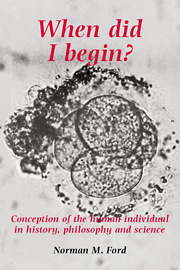Book contents
- Frontmatter
- Contents
- Foreword
- Preface
- 1 Introduction
- 2 Historical influence of Aristotle on the theory of human reproduction
- 3 Criteria for being a human individual
- 4 Fertilization and the beginning of a human individual
- 5 Implantation and the beginning of the human individual
- 6 The human individual begins after implantation
- Appendixes
- Notes
- Glossary
- Index
5 - Implantation and the beginning of the human individual
Published online by Cambridge University Press: 03 February 2010
- Frontmatter
- Contents
- Foreword
- Preface
- 1 Introduction
- 2 Historical influence of Aristotle on the theory of human reproduction
- 3 Criteria for being a human individual
- 4 Fertilization and the beginning of a human individual
- 5 Implantation and the beginning of the human individual
- 6 The human individual begins after implantation
- Appendixes
- Notes
- Glossary
- Index
Summary
It is now necessary to examine the stages of embryonic development after fertilization to see when the human individual begins. This will be done by way of exclusion by attempting to establish the last stage, or time, prior to which it would appear impossible, or at least implausible, for a human individual to be present in an ontological sense. In the following pages I shall first consider why it would seem that the individual human person could not be present during the early cleavage stage before the formation of the morula. In this section I will further discuss the implications of identical twinning for the beginning of the human individual, even though identical twinning can occur beyond this stage right up until implantation is almost completed. Arguments will then be presented that favour delaying hominization, or the formation of the human individual, beyond compaction and the morula stage. Next I will consider the relevance of naturally occurring short-lived parthenogenetic development that probably does occasionally occur in the human species. Finally, I shall examine evidence that suggests that the human individual could not actually exist before the formation of the blastocyst and its successful implantation in the womb about 13 days after fertilization.
The human individual not present during the early cleavage stage
Possibility of identical twinning during the early cleavage stage
It is important to bear in mind that the development of eutherian mammalian embryos differs quite significantly from that of amphibians. Of crucial importance for the former is the prior formation of extra-embryonic tissues and membranes (e.g. placenta), whereas the latter have no such need.
- Type
- Chapter
- Information
- When Did I Begin?Conception of the Human Individual in History, Philosophy and Science, pp. 132 - 163Publisher: Cambridge University PressPrint publication year: 1988
- 1
- Cited by



